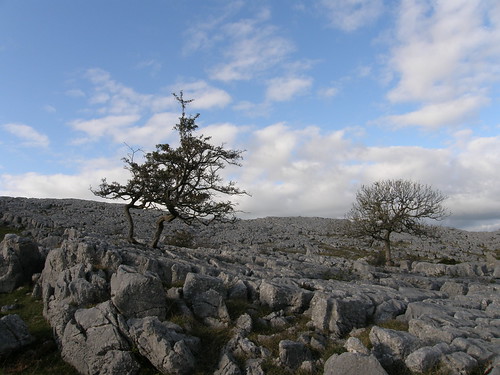On Sunday afternoon, Sam and I took advantage of the glorious weather and got out for another walk, this time on Farleton Fell. Well…I went for a walk, and Sam came along for a carry. We have a good view of Farleton Fell from our house, but I haven’t climbed it for ages. Seeing it everyday, I’ve been wanting to revisit for some time.
It’s a small hill, and with places to park on the verges of the narrow road that crosses over from Clawthorpe to Hutton Roof it can be climbed in just over an hour, even at my pace.
Like our walk of the morning, this route is dominated by limestone pavement.

There are far fewer trees growing out of the grykes, presumably because of the sheep. Farleton Fell’s higher but less conspicuous neighbour, Hutton Roof Crag is thoroughly overgrown with thickets of small trees, thorny shrubs and brambles. Since the topography of Hutton Roof Crag is also quite complex it makes for interesting navigation. I was talking to my old friend The Adopted Yorkshireman, when we walked in the White Peak recently, about wooded hills. In the UK the hills are generally pretty bare of trees. I was contending that this is because the woods were cleared for timber, charcoal and to make way for sheep – which may not be right but sounds plausible. The Adopted Yorkshireman opined that this is something we should be thankful for, because it means that we always have a clear view. Now normally, there’s nothing I like more than to pick a fight, especially with The Adopted Yorkshireman who always has an opinion and a cogent argument to back it up. But on this occasion I didn’t rise to the bait. Personally, I’d settle for occasional and partial views if those views were of wide stretches of woodland. Years ago I was walking near Kirby Lonsdale with my friend Valerie. We were ostensibly there to see some of Andy Goldsworthy’s sheep bields, but I was more impressed with the view. Valerie is French, and grew up near to the Pyrenees. When I asked her what she thought of the view, she replied simply: “Where are the trees?”
There are other things growing in the grykes, like this Hart’s Tongue Fern:

Without trees there aren’t so many birds either, but we were taken with this wheatear.

Apparently the name has nothing to do with either wheat or ears, but is actually from old Norse and translates as white-arse.
A board near to the top of Farleton Fell informed that it now belongs to the National Trust and that they call it Holme Park Fell. But I know that on maps dating back as far as the sixteenth and seventeenth centuries it appeared as Farleton Fell or Farleton Knot, so I’ll stick with the old name. On those same maps the hills are shown pictorially as rounded lumps and Farleton Fell is often shown disproportionately large, presumably because it rose so precipitately above the old coach road through Burton, just as it does now above junction 36 on the modern M6. Ironically, from the top there are views in almost every direction to much higher hills – the Lakeland Fells…

…the Forest of Bowland; over Scout Hill to the Howgills…

…and the hills above Barbon and Kirby Lonsdale. Perhaps the best view is of Ingleborough…

…which was also oversized on old maps because for a long time it was thought to be the highest hill in England.
Why am I so well informed about old maps? Because last week I went to a fascinating talk on the subject by Doctor Ian Saunders, who collects antique maps. Most old maps were bound into Atlases or printed on huge unfolded sheets. The first folding maps, recognisably like our modern walking maps, backed onto linen, were produced in 1644 for the parliamentarian forces in the civil war – Dr Saunders had one of those maps with him. The first UK maps to show roads were printed in 1676 on playing cards – because there were 52 counties in England and Wales – each card showed a county. As a lover of both card games and maps – I want a set! Sadly, even single original cards are very expensive.

Hmmm…through the wonders of Google I’ve discovered that I can buy a facsimile set for £10…..
The talk was in the village hall at Yealand, which is practically on the doorstep, but I only found out about it two days before. Dr Saunders is a physicist and the tutor of a friend who told me about the talk whilst accompanying A and I to yet another talk, this time about Einstein, particle physics and the Large Hadron Collider. The talk, given by Professor Brian Foster of Oxford university, was very engaging and was punctuated by astonishing violin playing from Jack Liebeck and the professor himself – the connection being that Einstein was a very keen violinist. They also do a talk with music on Superstrings – if they come to a venue near you I strongly recommend it. Professor Foster has the rare gift of making complex ideas accessible to a lay audience.